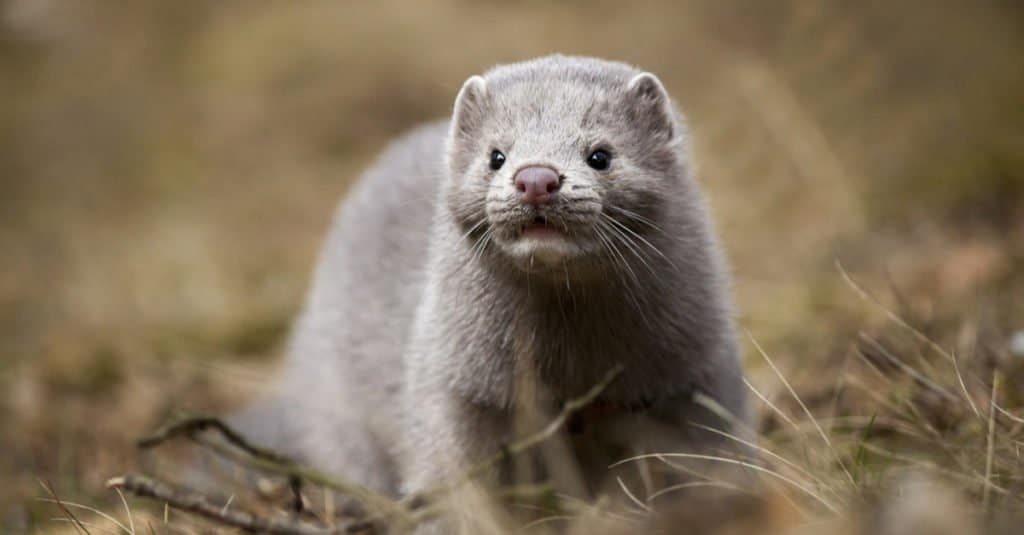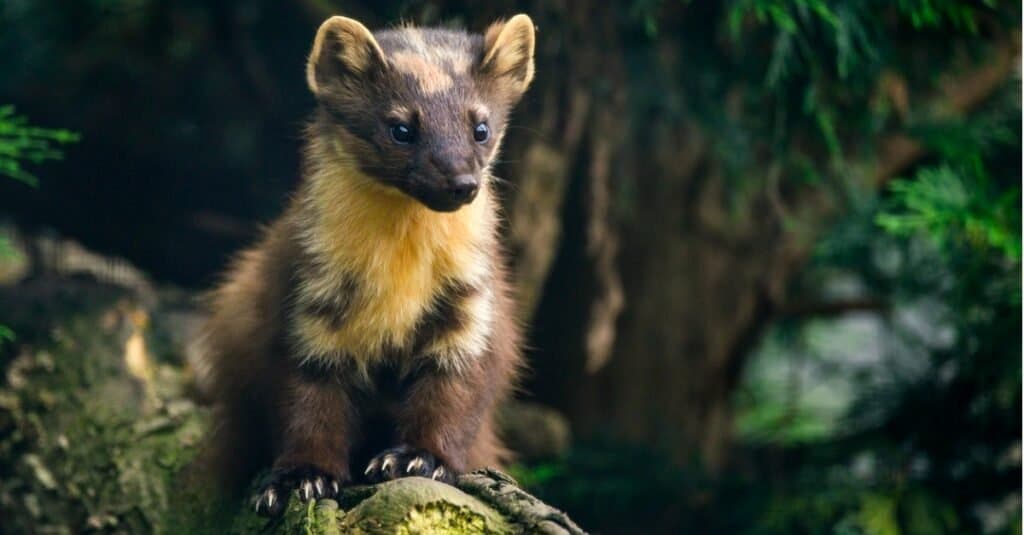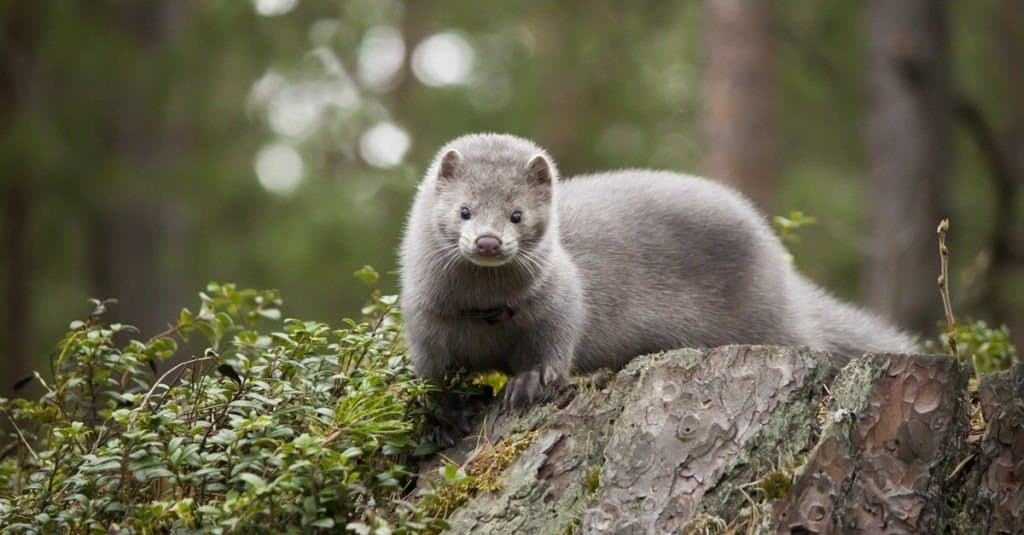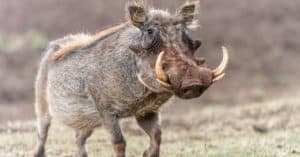Pine martens are often mistaken for minks due to their similar appearance. Indeed, their bodies have many things in common, and their size is approximately the same. However, other factors can help you distinguish them.
Keep reading this article to learn how to differentiate pine martens from minks!
Comparing Pine Marten vs Mink
| Pine Marten | Mink | |
|---|---|---|
| Size | Body length: 16.5 – 20.5 inches Tail length: 9 – 11 inches Weight: 1 – 3 pounds | Length: 12 – 18 inches Tail length: 5.9 – 10 inches Weight: 1 – 2 pounds |
| Appearance | – Light to dark brown fur; – Short in the summer, longer in the winter; – Has a yellow mark on its throat; – Small, rounded ears, small dark eyes, semi-retractable claws, sharp teeth | – Elongated bodies, short limbs, broad heads, short ears; – Can be dark brown or reddish brown with white spots on the underparts; – The American minks have longer tails |
| Classification | Kingdom: Animalia Phylum: Chordata Class: Mammalia Order: Carnivora Family: Mustelidae Genus: Martes Species: Martes martes | Kingdom: Animalia Phylum: Chordata Class: Mammalia Order: Carnivora Family: Mustelidae Subfamily: Mustelinae Genus: Neogale and Mustela |
| Distribution and Habitat | Europe, Asia Minor, the Caucasus, Iran, Iraq, Syria; wooded areas | American minks are widely distributed in most of North America, except for arid areas, while European minks live only in isolated populations in several European countries; semi-aquatic environments |
| Diet | Officially classified as carnivores, but may feed on fruits, nuts, honey | Carnivores |
| Predators and Threats | Owl, red foxes, eagles, humans | Coyotes, wolves, foxes, owls, bobcats |
| Behavior | Arboreal lifestyle, active at night and dusk, territorial | Semi-aquatic lifestyle; territorial, not too vocal, aggressive if threatened, active during the dawn and dusk hours |
| Lifespan | 8 – 10 years | 10-12 years |
| Conservation status | Least Concern | Least Concern (American Mink), Critically Endangered (European mink) |
The Key Differences Between Pine Martens and Minks
While pine martens and minks may look similar, they differ in many other ways, including their scientific classification, distribution, the threats they face, and behavior. For example, when talking about pine martens, we refer to a single species, while the mink genus consists of two species.
Let’s learn more about the key differences between pine martens and minks!
Pine Marten vs Mink: Classification

There are two extant species of mink: the American mink and the European mink.
©Aleksandra Saveljeva/Shutterstock.com
One of the most important things to consider while highlighting the differences between pine martens and minks is that pine martens are a species while mink represent the Neogale and Mustela genera. There are two extant species of mink: the Neogale vison, called the American mink, and the Mustela lutreola, called the European mink. Another mink species was the Neogale macrodon, or the sea mink, but it went extinct in the 19th century.
When comparing pine martens with minks, we’ll have to consider the size, appearance, distribution, diet, and so on for both American and European minks. In this article, we’ll use an average between the two.
Pine Marten vs Mink: Size
Pine martens and minks have similar sizes. The average pine marten’s body length is 16.5 – 20.5 inches, plus the 9 – 11-inch tail. Minks are slightly shorter, measuring 12 – 18 inches long, with 5.9 – 10-inch tails. American minks are larger than European minks, so they’re closer to pine martens’ body structure.
Pine martens are considerably heavier, as they can weigh up to 3 pounds, compared to minks, which rarely reach more than 2 pounds.
Pine Marten vs Mink: Appearance

Pine marten fur is longer in the winter and shorter in the summer.
©iStock.com/Matt_Gibson
In terms of appearance, pine martens’ and minks’ fur changes during summer and winter. The pine marten’s fur is longer in the winter and shorter in the summer. On the other hand, the mink’s fur is short both during winter and summer, but it’s thick when it’s cold and coarse when it’s hot.
While pine martens have light to dark brown fur with a yellow mark on their throats, minks’ fur may be reddish brown or dark brown with white spots on the underparts. Their body structure is similar and adapted to running, swimming, and surviving nocturnal lifestyles. However, pine martens have longer legs and thicker tails.
Pine Marten vs Mink: Distribution
Pine martens live in pine forests, scrublands, or on rocky hillsides in Europe, Asia Minor, the Caucasus, Iran, Iraq, and Syria. In Europe, they’re common in Italy, Finland, France, Germany, and Russia.
The minks’ range is more complicated. First, the two species, the American mink and the European mink, are extremely different in terms of their distribution. American minks live in most parts of North America, except for arid areas such as California, Utah, or Nevada.
Over the years, they were introduced for commercial purposes in other parts of the world, including Argentina, South Chile, Norway, and Iceland. In some areas, they’re still alive, but they’ve disappeared from other countries.
On the other hand, European minks now live only in isolated populations in France, northern Spain, Romania, Ukraine, and parts of Russia, because their population has been steadily declining in the past 150 years. Before that, they lived in most of Eastern Europe.
Pine Marten vs Mink: Habitat and Behavior

Minks prefer living near water and rarely venture outside their usual habitat.
©Aleksandra Saveljeva/Shutterstock.com
Pine martens usually spend their time climbing or running on tree branches, hence their preferred habitat – the woods. They prefer spending their time alone and are shy creatures. These animals are active at night. Pine martens mark their long territories by bordering them with feces. They’re very aggressive when they’re defending their territories.
In contrast, minks prefer living near water and rarely venture outside their usual habitat. They risk leaving the area only when looking for rabbits, their favorite food. If they have a good water source, minks also live in towns. Like pine martens, they are territorial animals and can become quite aggressive towards intruders. They have long and narrow territories which can belong either to male or to female minks. Male minks won’t accept another male in their territories.
A mink’s territory consists of two areas – one serves as a “resting area,” while the other serves as space for food supply. Minks are also solitary animals that can sometimes spend entire days alone in one of the two areas in their territories.
Pine Marten vs Mink: Predators and Threats
Both pine martens and minks have natural predators, such as eagles, owls, or red foxes. When it comes to human-action threats, minks are at a higher risk.
Humans pose a threat to pine martens through loss of habitat. Some people kill the pine martens that attack their chickens or other animals. Their fur is used for commercial purposes in some parts of the world.
The minks’ story is more complex because their fur is widely used for fur jackets, coats, and capes. The steady decline of the European mink population might be linked to overhunting. For example, in the Soviet Union, in the 20th century, approximately 40,000 – 60,000 European minks were caught annually. In the 1960s, around 10,000 European minks were caught in Romania, and in the 1920s – around 3,000 in Finland.
Many American minks live on fur farms where they risk getting sick of various diseases, including coronaviruses or stereotypy. Stereotypy is an abnormal psychological behavior that minks develop when they are held in battery cages. These cages restrict their ability to move.
Up Next:
The photo featured at the top of this post is ©
Thank you for reading! Have some feedback for us? Contact the AZ Animals editorial team.






